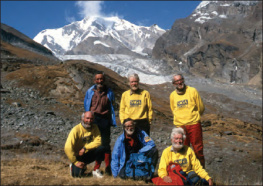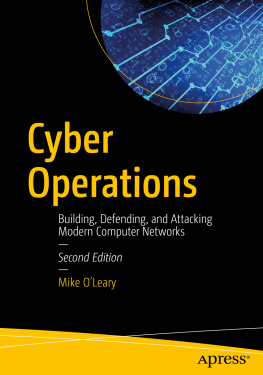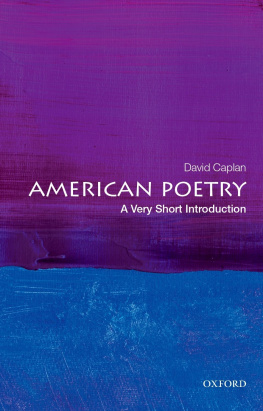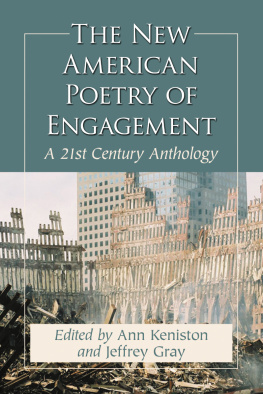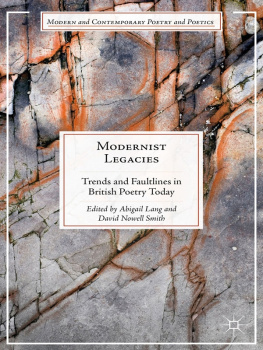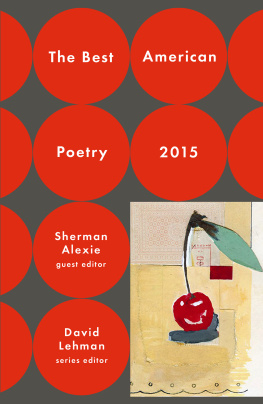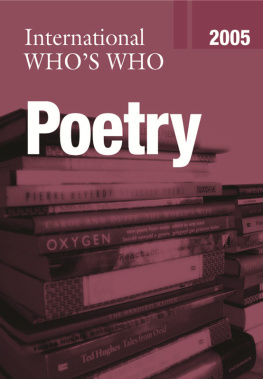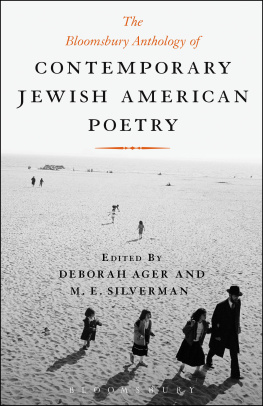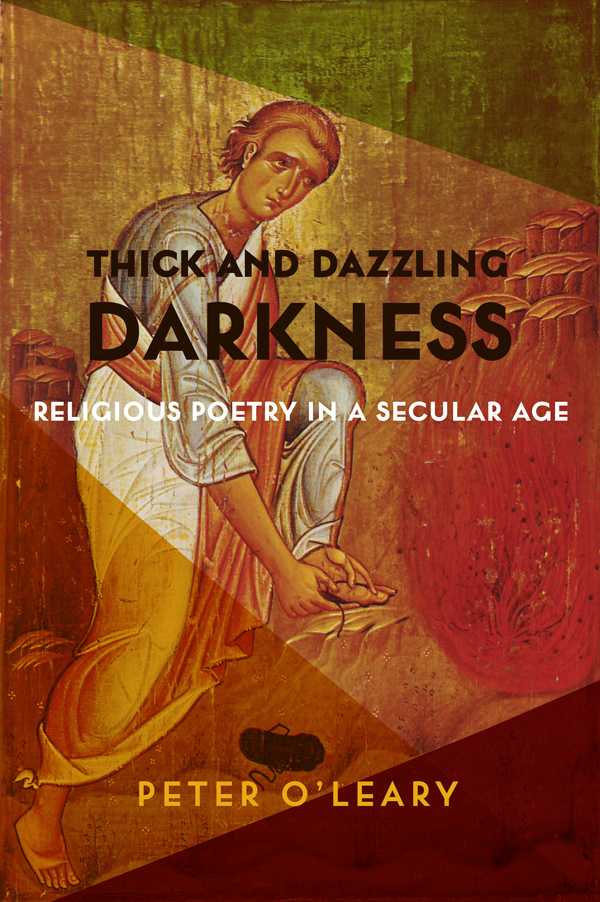Contents
Guide
Pagebreaks of the print version
THICK AND DAZZLING DARKNESS
THICK AND DAZZLING DARKNESS
RELIGIOUS POETRY
in a
SECULAR AGE
__________
PETER OLEARY
Columbia University Press
New York

Columbia University Press
Publishers Since 1893
New York Chichester, West Sussex
cup.columbia.edu
Copyright 2018 Columbia University Press
All rights reserved
E-ISBN 978-0-231-54597-6
Library of Congress Cataloging-in-Publication Data
Names: OLeary, Peter, 1968 author.
Title: Thick and dazzling darkness : religious poetry in a secular age / Peter OLeary.
Description: New York : Columbia University Press, 2017. | Includes bibliographical references and index.
Identifiers: LCCN 2017007545 (print) | LCCN 2017024983 (ebook) | ISBN 9780231173308 (cloth : alk. paper)
Subjects: LCSH: Religious poetry, AmericanHistory and criticism. | American poetry20th centuryHistory and criticism. | Religion in literature. | Religion and literature.
Classification: LCC PS310.R4 (ebook) | LCC PS310.R4 O44 2017 (print) | DDC 811.009/382dc23
LC record available at https://lccn.loc.gov/2017007545
A Columbia University Press E-book.
CUP would be pleased to hear about your reading experience with this e-book at .
Jacket image: Moses and Bush Icon, Sinai, circa twelfth century
IN MEMORY OF MARK KRUPNICK
AND
FOR MICHAEL HELLER
AND NORMAN FINKELSTEIN

Our understanding is dimmer than Moses eye, we are ignorant of the backparts, or lower side of his Divinity; therefore to pry into the maze of his Counsels, is not onely folly in Man, but presumption even in Angels; [there is no thread or line to guide us in that Labyrinth]
Sir Thomas Browne, Religio Medici
CONTENTS
M any of these chapters previously appeared as essays in periodicals and anthologies. first appeared as Apocalypticism: A Way Forward in Poetry, Chicago Review 55, no. 34 (Autumn 2010). In all cases, the essays have been revised and modified, and in one instance considerably, from their original appearance. Nevertheless, I remain grateful to the editors of these journals and anthologies, especially to Eirik Steinhoff, Jeff Hamilton, Albert Gelpi, the late Robert J. Bertholf, Nate Dorward, Keith Newton, James Maynard, V. Joshua Adams, and Joshua Kotin, each of whom had a hand in improving these essays for publication.
Institutional support from the School of the Art Institute of Chicago, in the form of two Faculty Enrichment Grants, helped toward the completion and publication of this book. Furthermore, Id like to thank Paul Ashley at SAIC for his support of this project, as well as Teena McClelland and Kelly Christian in the Liberal Arts office.
Ongoing conversations with some of the poets who are the subject of this book have been a source of inspiration and keen pleasure. To Lissa Wolsak, Fanny Howe, Nathaniel Mackey, Joseph Donahue, and Pam Rehm, my sincere thanks. To these, I would add my brother Michael, Joel Felix, and Devin Johnston, always ready to talk cosmos and bunk. At a crucial point in revising the introduction, Joshua Corey provided helpful insight and perspective.
The comments of the three outside reviewers of the manuscript of this book have been helpful in revising, preparing, and adjusting it for publication. I thank them for the improvements they have suggested.
Philip Leventhal, my editor at Columbia University Press, has been like an excellent baseball manager through the editorial process, improving my fielding skills with focused drills, helping me work on my batting stance, and then giving unambiguous signs for when to bunt and when to swing for the fences. Owing to his leadership, I am hopeful about our prospects in the playoffs.
Though this book largely involves itself with the Christian imagination, it has its roots in the studies that Jewish American scholars and poets have made of Jewish American literature. If there are guide signs for American poets invested in describing a Christian vision of things, they have been placed for us by the Jewish scholars and poets who have gone before us. For this reason, I dedicate this book to the memory of Mark Krupnick, my mentor and advisor at the Divinity School of the University of Chicago, whose explorations of the deep places in the imagination have led me to my own. And then also to Michael Heller and Norman Finkelstein. Both poets have been mentors and friends to me, unstinting in their kindness and support, true models as hermeneuts and poets for living the life in this art form. My debt to both Michael and Norman is profound.
To my wife, Rebecca, who makes all things possible, my love and thanks. And to our sons, Gabriel and Lucian, may this be a curious container of things I was thinking about when you were boys.
STEPPING BACKWARDS INTO THE DIVINE DARKNESS
Here is the description in the Authorized Version of Gods appearance on Mt. Sinai in Exodus 20:21: And the people stood afar off, and Moses drew near unto the thick darkness where God was . These words arrive moments after Moses has first heard God utter the Ten Commandments to him. Richard Eliot Friedman, in his Commentary on the Torah , translates: and Moses went over to the nimbus where God was. Thomass twin brother Henry, aspiring to the indefinite, puts it more directly in The Night:
There is in God (some say)
A deep, but dazling darkness; As men here
Say it is late and dusky, because they
See not all clear;
O for that night! where I in him
Might live invisible and dim.
Imagine Moses, then, in the act of giving the Law to Israel. The Israelites are terrified. Seismic upheavals have anticipated Gods commandments. Their souls are quaking. And all the people saw the thunderings, and the lightnings, and the noise of the trumpet, and the mountain smoking (Exod. 21:18). In a fright, the people ask Moses to speak on their behalf, not wanting to confront this potent divinity themselves. Telling them not to be afraid, he suddenly steps into the dizzying thick darkness, where the Lord speaks to his prophet, instructing him to erect an altar whereon Moses and his kind will make sacrifices. For which God promises to bless them forever after. Mosess contact with God in this moment stands for the symbolic acts of the religious poet: though the atmosphere is gloomy and ominous and the location strenuous to get to, the divine is present, and there is the prospect of law, covenant, revelation, and genuine power.
Thick and Dazzling Darkness is a book about the role religion and a religious worldview play in the work of a handful of modern and contemporary poets working in North America. Its also about writing and reading religious poetry in a secular age. Its commonplace to hear that we live in a secular age, but what does this mean? More to the point, what does it mean for the poets who are the subject of this bookFrank Samperi, Robinson Jeffers, Geoffrey Hill, Robert Duncan, Lissa Wolsak, Fanny Howe, Nathaniel Mackey, Joseph Donahue, and Pam Rehmto write religious poetry, which is to say, to choose to write religious poetry in a secular culture in which religion has ceased to carry the meaningboth cultural and literarythat it has in the past? The purpose of this book is to discuss the role religion plays in the poetry these poets have written and also to place their religious worldviews in contextone that includes both spiritual and literary-historical meanings. My title serves to prepare the way Im imagining into this material.


